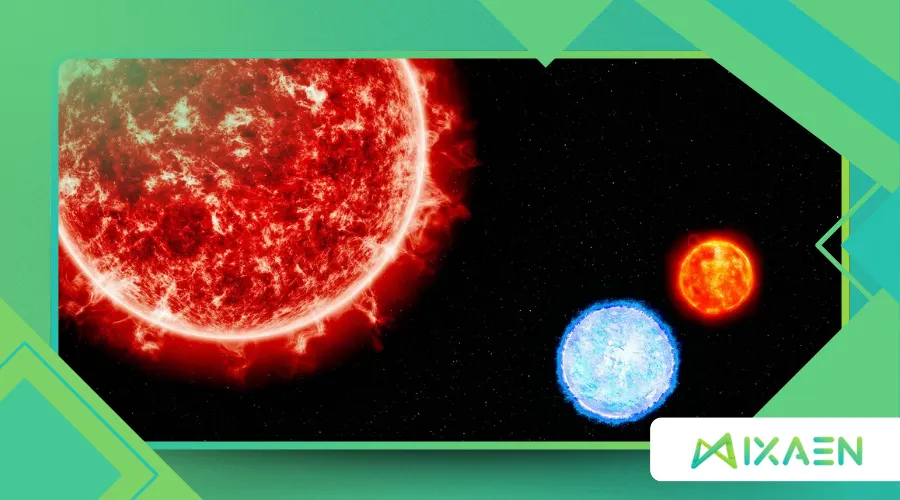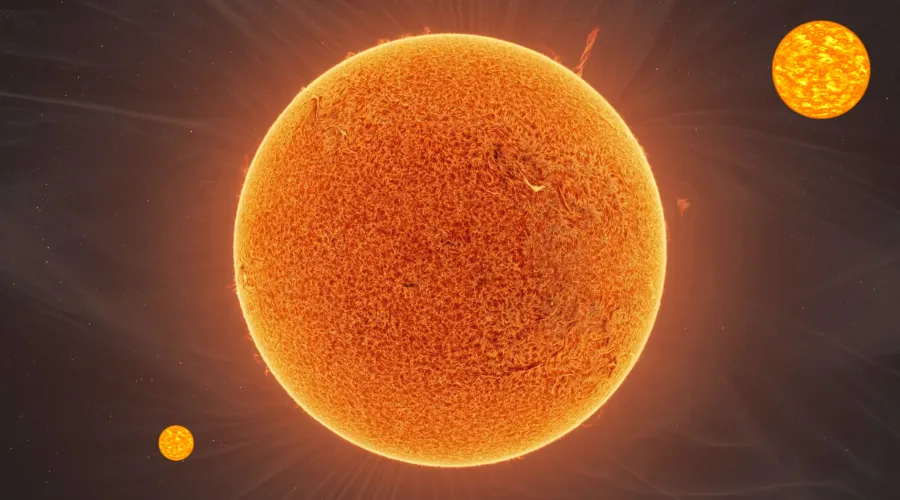The Three-Body Problem: Unraveling Chaos in Multiple Star Systems

The three-body problem is a cosmic puzzle that has baffled astronomers and mathematicians for centuries, a celestial dance where three stars interact in unpredictable ways.
Anúncios
Unlike the tidy orbits of a two-body system—like Earth and the Sun—adding a third star introduces chaos, defying simple predictions.
This phenomenon, rooted in Newtonian gravity, reveals the universe’s complexity, where small changes spark dramatic outcomes.
In this exploration, we’ll dive into the science, implications, and real-world examples of this stellar conundrum, uncovering why it matters to astronomy and beyond.
The Physics of Cosmic Trios
At its core, the three-body problem asks: how do three massive objects move under their mutual gravitational pull?
Isaac Newton’s laws work beautifully for two bodies, yielding predictable elliptical orbits.
But introduce a third, and the system becomes a mathematical beast.
No general analytical solution exists—each body’s motion depends on the others, creating a feedback loop of ever-shifting forces.
This sensitivity to initial conditions, a hallmark of chaos theory, means tiny differences in starting positions can lead to wildly different paths.
Consider a hypothetical system: three stars of equal mass, initially at rest in a triangular formation.
Their gravitational tug pulls them inward, but not symmetrically.
One star might slingshot past another, while the third drifts, only to be yanked back later.
The result? A chaotic ballet, impossible to predict long-term.
This complexity fascinated 18th-century mathematicians like Euler and Lagrange, who found special cases—like stable equilateral configurations—but these are rare in nature.
A 2019 study in Physical Review Letters highlighted the stakes: researchers simulated 1,000 three-body interactions, finding that 85% ended in one star being ejected, leaving a binary pair.
This statistic underscores the inherent instability of such systems, shaping our understanding of stellar evolution.
Moreover, the implications extend beyond theoretical physics; they influence our understanding of star formation and the lifecycle of galaxies.
By studying these chaotic interactions, scientists gain insights into how stars cluster and evolve over cosmic time scales.
+ What Are Blue Supergiant Stars and Why Are They So Mysterious?
Why the Three-Body Problem Matters
The three-body problem isn’t just a theoretical curiosity—it’s a key to unlocking the universe’s dynamics.
Multiple star systems, where three or more stars orbit together, are surprisingly common.
About 10% of stars in our galaxy belong to such systems, and their chaotic interactions drive dramatic events: star ejections, mergers, or even supernovae.
By studying these systems, astronomers decode the history and future of stellar populations.
Take the Alpha Centauri system, our closest stellar neighbor.
It’s a triple system with two Sun-like stars (Alpha Centauri A and B) and a distant red dwarf (Proxima Centauri).
While stable now, its long-term fate hinges on gravitational interplay.
Could Proxima drift closer, disrupting the binary pair?
Such questions push astronomers to model these systems with ever-greater precision, using supercomputers to simulate millions of years in seconds.
Beyond stars, the three-body problem informs exoplanet searches.
Planets in triple-star systems face chaotic perturbations, affecting their habitability.
Understanding these dynamics helps prioritize targets for telescopes like the James Webb Space Telescope, hunting for life-friendly worlds.
For more insights into the implications of multiple star systems, visit NASA’s Exoplanet Exploration.
This resource provides valuable information on how exoplanets are studied and the effects of their star systems on potential habitability.
Chaos Theory and Stellar Dance
Chaos theory, born from the three-body problem, reveals why these systems are so unruly.
A chaotic system amplifies small changes exponentially.
Imagine a cosmic billiards table: nudge one ball slightly, and the entire game shifts.
In a triple-star system, a minor velocity change can send one star spiraling out or crashing into another.
This unpredictability challenges astronomers to rely on numerical simulations rather than elegant equations.
An original example illustrates this.
Picture the fictional “Trisolaris” system: three stars of different masses orbiting in a loose cluster.
Initially, they trace intricate loops, but a passing comet grazes one star, altering its path by a fraction.
Within millennia, one star is flung into interstellar space, while the others form a tight binary.
This scenario, while invented, mirrors real systems where chaos reigns.
The three-body problem also inspired breakthroughs in mathematics.
Henri Poincaré, studying it in the 1880s, laid the groundwork for chaos theory, showing that deterministic systems could still be unpredictable.
His work resonates today in fields from meteorology to stock market analysis, proving the problem’s far-reaching impact.
Additionally, the mathematical principles derived from the three-body problem have applications in various scientific disciplines, including robotics and engineering.
These principles help in designing systems that can predict and adapt to chaotic environments, showcasing the problem’s interdisciplinary significance.

Real-World Examples in the Cosmos
Multiple star systems offer a front-row seat to the three-body problem’s drama.
Consider the Algol system, a triple-star setup 93 light-years away.
Algol A and B form a close binary, while Algol C orbits farther out.
Their interactions create periodic brightness changes, visible to early astronomers.
Simulations suggest Algol C’s gravitational pull subtly alters the binary’s orbit, a slow-motion chaos that could reshape the system over millions of years.
Another example is the fictional “Zeta Triad” system, imagined for this discussion.
Three stars—two massive blue giants and a smaller white dwarf—orbit in a delicate balance.
The white dwarf, zipping closer to one giant, triggers a gravitational tug-of-war.
Over eons, the dwarf might siphon material from a giant, sparking a nova.
This dynamic, grounded in real astrophysics, shows how the three-body problem drives stellar evolution.
Why do these examples matter?
They reveal how chaotic interactions sculpt galaxies.
Ejected stars become “runaways,” zipping through space, while mergers create massive stars that explode as supernovae, seeding the cosmos with heavy elements.
The three-body problem, then, isn’t just a puzzle—it’s a cosmic engine.
Moreover, understanding these interactions aids in predicting the future of our own solar system and the potential for life in other star systems.
By analyzing these complex dynamics, scientists can make informed predictions about stellar evolution and its implications for planetary systems.
Challenges in Modeling Triple Systems
Simulating the three-body problem demands immense computational power.
Each star’s position, velocity, and mass must be tracked precisely, with calculations updated at tiny time intervals.
Even then, chaos ensures that long-term predictions are probabilistic, not certain.
Astronomers use “N-body” simulation codes, like those developed for the AMUSE framework, to model these systems, but limitations persist.
One hurdle is the “timescale problem.”
Stellar interactions unfold over millions or billions of years, but simulations can’t track every second.
Instead, they use approximations, which introduce uncertainties.
Another challenge is incorporating additional forces—stellar winds, magnetic fields, or nearby stars—that complicate the gravitational dance.
| Challenges in Simulating Three-Body Systems |
|---|
| Challenge |
| Computational Demand |
| Timescale Problem |
| Additional Forces |
| Chaos Sensitivity |
Furthermore, as computational technologies advance, the ability to simulate these complex systems will improve, leading to more accurate predictions.
Innovations in quantum computing, for example, could revolutionize how we approach these simulations, allowing for real-time modeling of chaotic interactions.

Implications for the Future
The three-body problem shapes the future of astronomy and space exploration.
As telescopes grow more powerful, detecting triple-star systems becomes easier, offering new datasets to test theories.
The Vera C. Rubin Observatory, set to begin operations in 2025, will map millions of stars, identifying chaotic systems for study.
These observations could refine our models of galactic evolution, revealing how multiple star systems influence star formation.
For space exploration, understanding these dynamics is crucial.
Imagine a future mission to a triple-star system.
Navigating its chaotic gravitational fields would require precise trajectory planning, informed by three-body simulations.
Could we ever predict a safe path through such a system?
This question engages both scientists and dreamers, pushing the boundaries of what’s possible.
The problem also inspires interdisciplinary innovation.
Its mathematical complexity drives advances in artificial intelligence, where machine learning algorithms tackle chaotic systems.
These tools could predict stellar outcomes or optimize spacecraft trajectories, bridging astronomy and engineering.
Moreover, the insights gained from studying the three-body problem may one day contribute to the development of new propulsion technologies, enhancing our ability to explore distant star systems.
As we continue to unravel these cosmic mysteries, the potential for discovery remains boundless.
++ Ever Heard of a ‘Solar Particle Shower’? Discover This Cosmic Phenomenon
A Cosmic Analogy
Think of the three-body problem as a galactic tug-of-war.
Three players, each pulling on ropes tied to the others, struggle to find balance.
A slight tug from one shifts the entire game, sending players stumbling or sprinting.
In the cosmos, stars are the players, gravity the ropes, and chaos the referee, ensuring no simple victory.
This analogy captures the problem’s essence: a delicate balance, ever on the brink of disruption.
As we better understand these dynamics, we can draw parallels to other complex systems in nature, from ecosystems to social structures.
Recognizing these connections enriches our comprehension of chaos and order across different fields of study.
Conclusion: Embracing the Chaos
The three-body problem is more than a mathematical enigma—it’s a window into the universe’s wild heart.
From shaping stellar destinies to challenging our computational limits, it reveals the cosmos as a place of order and chaos intertwined.
By studying triple-star systems, we uncover the forces that sculpt galaxies, drive supernovae, and perhaps even influence life’s origins.
As we peer deeper into the stars, this problem reminds us: the universe is no simple machine, but a symphony of unpredictable beauty.
The pursuit of understanding the three-body problem continues to inspire generations of scientists, mathematicians, and dreamers, as we strive to decode the mysteries of the cosmos.
In doing so, we not only expand our knowledge of the universe but also enrich our understanding of our place within it.
